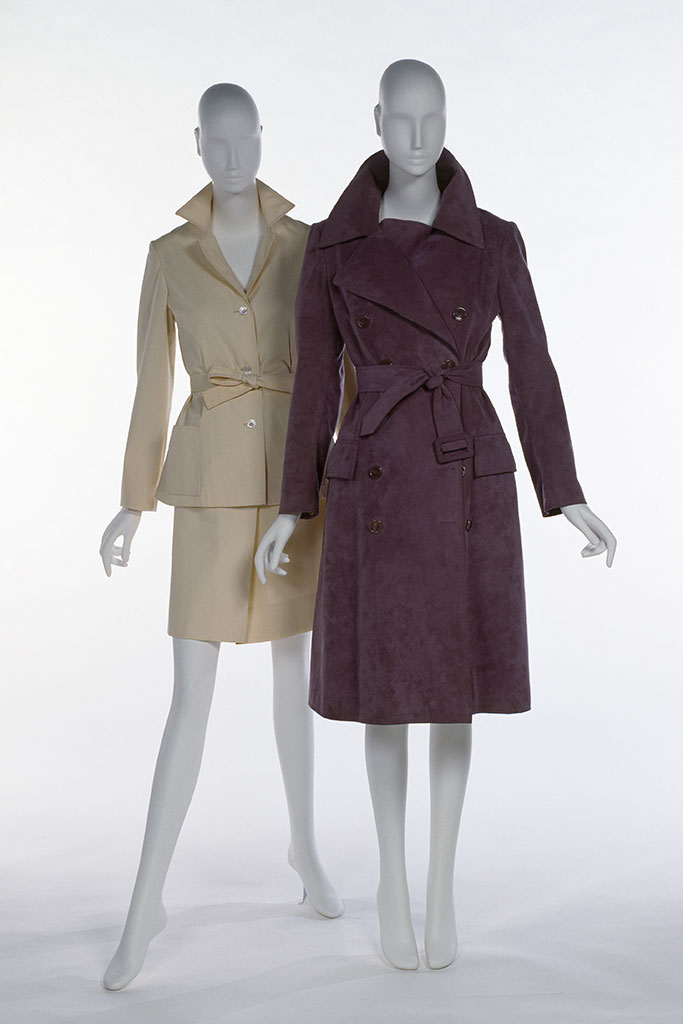Menswear: Halston + Ultrasuede
- By The Museum at FIT
- In Object post
- On 26 Feb | '2015
Today we bring you an excerpt from our Special Exhibitions Gallery on Halston + menswear:
“Halston perfected a spare but luxe choice of unisex elements that became the foundation of his daytime designs for women. These pieces were nearly identical to the daily uniform that Halston himself wore: a cashmere turtleneck, a matching cardigan or loosely cut jacket, and a pair of trim trousers. His most famous garment, the shirtwaist dress, was a subtle adaptation of a man’s shirt. Made of Ultrasuede, a machine washable fabric, the shirtwaist dress was subtle and sexy, with buttons that commenced at the breastbone rather than the neckline. It became a fashion staple.”

Halston at the Plaza Hotel, New York, 1978. Photograph by Roxanne Lowit. © Roxanne Lowit.
Halston first saw Ultrasuede on Issey Miyake in Paris in 1971. Miyake was wearing one of his own designs made with Ultrasuede, and when Halston saw the fabric, he believed it was waterproof. Halston’s first Ultrasuede design was a trench coat which absorbed water rather than repelling it. It was a happy accident, however; he designed the Ultrasuede shirtwaist dress soon after, also known as the shirt-dress.

(left) Halston ensemble, off-white polyester poplin, c. 1972, USA, 76.69.19, Gift of Lauren Bacall
(right) Halston coat, purple Ultrasuede, c. 1974, USA, 78.242.170, Gift of Mrs. Jefferson Patterson © MFIT
Halston’s shirtwaist dress was first known as “model number 704,” and it was introduced in the fall of 1972. In the book accompanying the exhibition, curator (and MFIT deputy director) Patricia Mears outlines the elements of construction that made this dress more than a “copy” of a man’s shirt:
In many ways, its construction is like that of a man’s shirt: it has a set-in collar; a yoke in back; long, set-in sleeves that end in a two-button cuff; and is rather straight cut. Halston subtly modified a number of these elements: the collar is a bit oversized and sharply pointed. The sleeves are tighter than those of a man’s shirt and are set into smaller armholes, and the shape is slightly A-lined. The most dramatic difference from its menswear antecedent is the placement of the buttons, which commence at the breastbone rather than at the neckline. For more and more women early in the 1970s, a slim figure achieved though diet and exercise had become the beauty standard. Many young women also embraced the concurrent trend of discarding their brassieres. Halston obliged them and his shirtwaist dress was, according to some, the first low décolletage seen on an item of daytime sportswear. It is further feminized with the inclusion of a separate but matching wide belt that could be wrapped in any manner the wearer chose.
Mears continues:
“Menswear informed his best-known designs, and found its way into many of Halston’s key garments. Yet Halston did not opt to create women’s clothing that looked as if it was literally borrowed from a man’s wardrobe. Instead, he created a range of classic pieces that reflected his own, subtly unisex style.”
For more on Halston + menswear, be sure to read the essay in the book Yves Saint Laurent + Halston: Fashioning the 70s. Love this post? Share it on social media with the links below, and don’t forget to tweet us with #YSLhalston.
-MM




 Interview:
Interview: